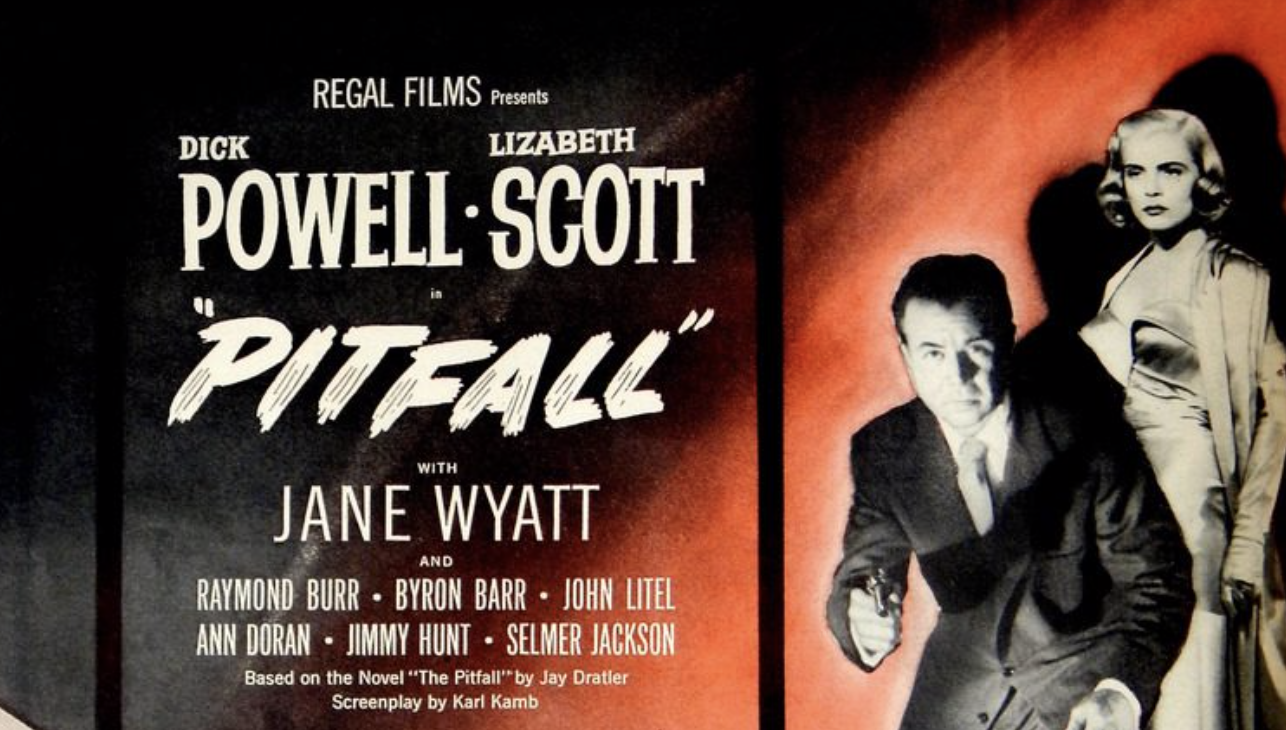How ‘Pitfall’ Got Around Hollywood’s Self-censoring Production Code

- Funny
- Offensive
“No picture shall be produced which will lower the moral standards of those who see it.”
January 30th, 2019 – On August 24th, 1948 United Artists released the noir crime film Pitfall, a film centering around an affair that leads, inevitably, to murder. The film, however, was almost lead to the cutting room floor after the Motion Picture Production Code demanded changes to the film in order to adhere to its rule of not showing adultery as attractive.
Director Andre De Toth had a pretty simple but gutsy response. He chose to meet with members of the Production Code board. His criteria for that meeting? Be on the board and currently be having an affair. De Toth selected two people who were both having affairs, and after that meeting the board didn’t seem to have any further issues.

Whether you label that tactic as blackmail or a moment of realized hypocrisy, Pitfall was able to keep the storyline as it was originally written for the screen by Karl Kamb. Throughout the film, Johnny, a married insurance investigator who falls for the woman he’s been assigned, has to deal with the fallout of his actions but is ultimately forgiven by his wife and cleared for his crimes.
These results didn’t match up with the Motion Picture Production Code, originally created in 1930 but enforced in 1934.
In section II of the code, labeled “Sex,” the rules are laid out for adultery:
“The sanctity of the institution of marriage and the home shall be upheld. Pictures shall not infer that low forms of sex relationship are the accepted or common thing.
1. Adultery and illicit sex, sometimes necessary plot material, must not be explicitly treated or justified, or presented attractively.”
Will Hays, president of the Motion Picture Producers and Distributors of America from 1922 – 1945, helped craft the original dos and don’ts. This censorship was, of course, self-inflicted but done so as a response to backlash over prior racier films and in an attempt to avoid perhaps stricter censorship from the government.
While it may seem quaint that a film with an actress who was “scantily clad” would cause uproar when the film for Best Picture in 2018 had a scene where a woman had sex with a fish-man, that was simply the case. In 1921, legislators in 37 states introduced nearly 100 movie censorship bills.

Fearing the governmental crackdown, the film industry decided to crack into itself.
The “General Principles” guiding the Code rules stated:
1. No picture shall be produced which will lower the moral standards of those who see it. Hence the sympathy of the audience shall never be thrown to the side of crime, wrong-doing, evil or sin.
2. Correct standards of life, subject only to the requirements of drama and entertainment, shall be presented.
3. Law, natural or human, shall not be ridiculed, nor shall sympathy be created for its violation.
Following those mandates, it went on to lay out “Particular Applications” such as crime, sex, vulgarity, religion, profanity, dances, and national feelings.
“The use of the flag shall be consistently respectful.”
“No film or episode may throw ridicule on any religious faith. Ministers of religion in their character as ministers of religion should not be used as comic characters or as villains.”
“Drug addiction or the illicit traffic in addiction-producing drugs shall not be shown if the portrayal:
(a) Tends in any manner to encourage, stimulate, or justify the use of such drugs.”“Pointed profanity (this includes God, Lord, Jesus, Christ —
unless used reverently — Hell, S.O.B., damn, Gawd), or other profane or vulgar expressions, however used, is forbidden.”“Obscenity in word, gesture, reference, song, joke or by suggestion (even when likely to be understood only by part of the audience) is forbidden.”
“Excessive and lustful kissing, lustful embraces, suggestive postures and gestures are not to be shown.”
“Miscegenation (sex relationship between the white and black races) is forbidden.”

Some films found creative ways to get around the strict guidelines. Alfred Hitchcock had his actors pause their passion every three seconds in Notorious to skirt the timed kissing rule. Of course, that whole scene lasted for two and a half minutes of interrupted passion.
Films from that era weren’t technically required to get an approval code certificate, but forgoing the process made entry into theaters much harder. As the decades went by, however, enforcement of the code became difficult. With the success of racier foreign films, and the expansion of television programming, film distributors stop looking so closely at the rules.

After Frank Sinatra won the Best Actor Oscar for The Man With the Golden Arm (which didn’t receive code approval), and Some Like It Hot (another clearly non-approved film which finds Jack Lemmon and Tony Curtis in drag) became a hit, Hollywood realized its censorship rules wouldn’t last.
By 1968, the MPAA introduced the rating system, discarding censorship and setting age requirements for admission instead.
The following year, Midnight Cowboy was released with an “X” rating (it was later re-rated “R.” It won the Oscar for Best Picture in 1970.
